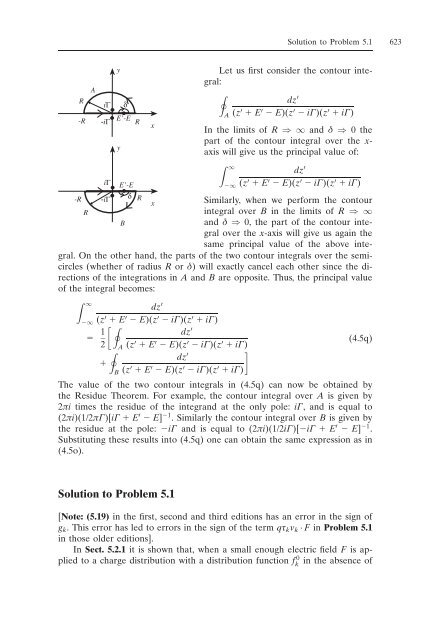10. Appendix
You also want an ePaper? Increase the reach of your titles
YUMPU automatically turns print PDFs into web optimized ePapers that Google loves.
R<br />
-R<br />
A<br />
y<br />
E’-E<br />
y<br />
E’-E<br />
R<br />
x<br />
Solution to Problem 5.1 623<br />
Let us first consider the contour integral:<br />
<br />
A<br />
dz ′<br />
(z ′ E ′ E)(z ′ i°)(z ′ i°)<br />
In the limits of R ⇒∞and ‰ ⇒ 0 the<br />
part of the contour integral over the xaxis<br />
will give us the principal value of:<br />
∞<br />
∞<br />
dz ′<br />
(z ′ E ′ E)(z ′ i°)(z ′ i°)<br />
-R<br />
R<br />
R<br />
x<br />
Similarly, when we perform the contour<br />
integral over B in the limits of R ⇒∞<br />
B<br />
and ‰ ⇒ 0, the part of the contour integral<br />
over the x-axis will give us again the<br />
same principal value of the above integral.<br />
On the other hand, the parts of the two contour integrals over the semicircles<br />
(whether of radius R or ‰) will exactly cancel each other since the directions<br />
of the integrations in A and B are opposite. Thus, the principal value<br />
of the integral becomes:<br />
∞<br />
dz<br />
∞<br />
′<br />
(z ′ E ′ E)(z ′ i°)(z ′ i°)<br />
1<br />
<br />
dz<br />
2 A<br />
′<br />
(z ′ E ′ E)(z ′ i°)(z ′ i°)<br />
<br />
dz<br />
<br />
B<br />
′<br />
(z ′ E ′ E)(z ′ i°)(z ′ (4.5q)<br />
<br />
i°)<br />
The value of the two contour integrals in (4.5q) can now be obtained by<br />
the Residue Theorem. For example, the contour integral over A is given by<br />
2applei times the residue of the integrand at the only pole: i°, and is equal to<br />
(2applei)(1/2apple°)[i° E ′ E] 1 . Similarly the contour integral over B is given by<br />
the residue at the pole: i° and is equal to (2applei)(1/2i°)[i° E ′ E] 1 .<br />
Substituting these results into (4.5q) one can obtain the same expression as in<br />
(4.5o).<br />
Solution to Problem 5.1<br />
[Note: (5.19) in the first, second and third editions has an error in the sign of<br />
gk. This error has led to errors in the sign of the term qÙkvk · F in Problem 5.1<br />
in those older editions].<br />
In Sect. 5.2.1 it is shown that, when a small enough electric field F is applied<br />
to a charge distribution with a distribution function f 0 k in the absence of










